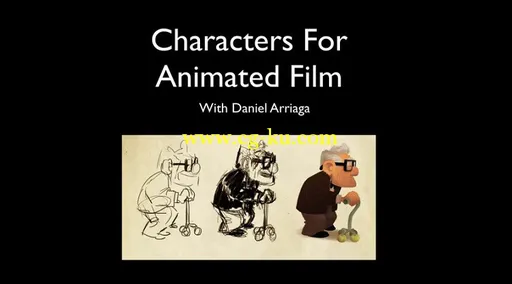
Schoolism – Self-Taught Characters for Animated Film
Title: Schoolism – Self-Taught Characters for Animated Film
Info:
Character designs for animated features need to be strong enough to capture the audience’s imagination for two hours and dynamic enough to tell an excellent story. In this course, Pixar character artist, Daniel Arriaga, will teach you his creative process for designing an animated film cast that will spark a connection with your audience and tell a riveting story.
You will learn about shape language, developing “character”, and enhancing your characters through expressive emotions, body language, and animated gesturing as well as many other principles vital to creating great characters for animated film.
Lesson 1 – Shape Language
In my first lecture, we will talk about shape language and how it applies to character design. We will examine the silhouettes of iconic cartoon characters and talk about why they read well. We will further discuss the use of shapes in various cultures throughout history, and how shapes affect character.
Lesson 2 – What is Character?
In this class, we will tackle the quintessential question: what is “character”? We will look at the works of more great designers to try to find the answer. This is a class for character design for film and storytelling, not television or illustration; we will talk about what the differences are, look at examples of designs with and without “character”, and discuss more about the importance of finding good reference before you even begin to design your characters.
Lesson 3 – Gesture and Mood
In telling an effective story, we need to understand lines of action and how to use them. We will break down shapes and talk about what to look for when drawing from life. I will help you create a clear silhouette and stage your characters so that their moods and gestures read clearly and easily.
Lesson 4 – Exaggeration
Exaggeration is a vital component to character design, but it must not be done at random. In this lesson, we’ll examine intelligent and tasteful exaggeration — how to identify the key defining features of a character and push them. We will also cover the importance of good drawing and staging.
Lesson 5 – Moments
In “Breaking Bad”, when Jesse and Mr. White cook together for the first, these respective characters have cinematic moments that add “true” character to their designs. In this lecture, we will discuss how dynamic story moments (body language, acting, staging, emotion, attitude) add “true” character to character designs.
Lesson 6 – Expressions
Good expressive emotion means conveying clearly to your audience what your character is thinking or feeling through their expressions. In this lesson, I will do an expression drawing demo and talk again about the effective use of reference, including using a rough sculpt to help us draw expressions from multiple angles.
Lesson 7 – Caricature
The best caricature artists can often draw a person with a better likeness than taking a photo because they can take character into account. In this lecture, we will talk about how caricature applies to character design, look at examples from great caricature artists, and do a caricature demo.
Lesson 8 – Finishing Touches
Finishing touches are our last opportunity to eliminate generic qualities from our character designs. I will demonstrate how to use texture and value to simplify shapes and enhance visual interest in a character.
Lesson 9 – No Fear!
In my final lecture, I will do demos of characters successfully finished to a clean up. We will talk about overarching issues for character designers: the many ways in which we can finish a design, how to avoid getting stale or bored, how to avoid insecurity and lethargy in your designs, and more.
Schoolism — — 自学字符动画电影
标题: Schoolism — — 自学字符动画电影
信息:
角色设计为动画功能需要强大到足以捕获了两个小时了听众的想象力和足够的活力,讲述一个优秀的故事。在此过程中,皮克斯字符艺术家,Daniel Arriaga 会教你设计动画的影片演员阵容,将引发与你的听众的连接和一个引人入胜的故事创作的过程。
你将了解形状语言发展"字符",和增强你的人物通过表达情感,身体语言,和动画以及许多其他原则至关重要创造伟大的人物动画电影打手势。
第 1 — — 造型语言课
在我第一次演讲中,我们将谈论造型语言和它如何应用于字符设计。我们会审核的标志性卡通人物剪影和谈论为什么他们好读的内容。我们将进一步讨论使用形状不同的文化,在整个历史上,和形状对性格的影响。
第 2 — — 课特征是什么?
在这节课,我们会解决的典型问题: 什么是"人物"?我们将看看更多伟大的设计师,试图找出答案的作品。这是一个类,用于电影和讲故事,而不是电视或插图; 角色设计我们将谈论差异的是,看在"字符",而设计的实例和详细讨论找到很好的参考之前你甚至开始设计你的人物, 的重要性。
第 3 — — 手势和情绪课
在有效的故事,我们需要了解行行动和如何使用它们。我们将打破形状,谈论如何寻找从生活在绘制时。我将帮助您创建一个清晰的轮廓和阶段你的人物,他们的情绪和手势读清楚和容易。
第 4 — — 夸张课
夸张是一个重要的组成部分,对个性的设计,但它必须不随意做。在本课中,我们将检查智能和雅致的夸张 — — 如何识别关键的有决定性的性格特征和推动他们。我们还将包括良好的绘图和分期的重要性。
第 5 — — 时刻课
在"坏",当杰西和怀特先生一起做为第一,这些各自的字符有电影的时刻,将"真实"的字符添加到他们的设计。在这堂课,我们将讨论如何动态时刻 (肢体语言、 代理、 分期、 情感、 态度) 添加"真实"的字符到设计的故事。
第 6 — — 表达式课
好情感表达手段向你的听众清楚地传达你的性格是思维或感觉通过他们的表情。在本课中,我将做表达式绘制演示和再谈有效使用的参考,其中包括使用一种粗糙的造型来帮助我们从多个角度得出表达式。
第 7 — — 漫画课
最好的漫画艺术家往往可以更好的肖像,比拍张照片,因为他们可以考虑字符画人。在这堂课,我们将谈论如何漫画适用于个性的设计,看看例子由伟大的漫画艺术家,并做一个漫画演示。
第 8 — — 最后的润色课
最后的润色是我们最后一次的机会,以消除通用素质从我们的角色设计。我将演示如何使用纹理和价值来简化形状和提高视觉兴趣一个字符。
9 — — 没有恐惧的教训!
在我最后一堂课,我将做演示的字符成功地完成了对清理。我们将谈论角色设计师的首要问题:我们可以完成一个设计,在许多方面如何避免陈旧或无聊的时候,如何避免不安全和昏睡在你的设计,和更多。